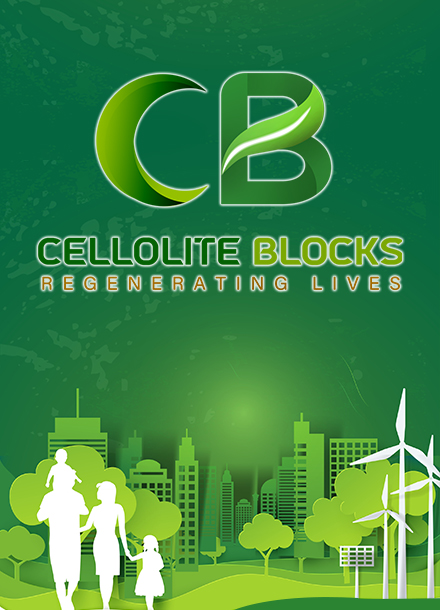ABOUT CELLOLITE BLOCKS
We Offers Best Quality
Eco Friendly Products
We hear terms like ‘eco-friendly’ and ‘environmentally-friendly’ all the time, but what do they really mean? Read our guide to find it out and understand the differences between ‘eco-friendly’, ‘green’ and ‘sustainable’.As we all become more aware of the climate crisis, and want to do our bit to fight it, these are necessary questions to ask. When everything from your washing-up liquid to your food is claiming to be good for the planet, it’s natural to want to know what that really entails.
Here’s a breakdown of what people actually mean when they say something is ‘eco-friendly’, ‘green’, or ‘sustainable’. Plus, read on for some tips on how to live more environmentally-friendly, and what we at CELLOLITE are doing to give back to the planet.
What does ‘eco-friendly’ mean?
‘Eco’ comes from the Latin root ‘oeco’, meaning ‘household’. It’s often used now to mean ‘habitat’, ‘home’, or ‘Earth’. And so, ‘eco-friendly’ simply means Earth-friendly.
According to the Cambridge Dictionary, being eco-friendly means being ‘designed to have little or no damaging effect on the environment.
Basically, it’s all about doing no harm. Products, events, and services that are eco-friendly don’t cost the Earth. When thinking about products in particular, it means looking at everything from how the product is made, to how it’s delivered. Does any part of that process harm the planet? If so, it’s not entirely eco-friendly.
What’s the difference between ‘eco-friendly’, ‘green’, and ‘sustainable’?
Like ‘eco-friendly’ the term ‘green’ generally means being kind to the Earth, often by trying to have a lighter carbon footprint. According to Birnur Aral PhD, from the Good Housekeeping Institute, the word green “generally implies better practices for both the environment and the people involved”.
It’s quite an informal, casual term that can be applied in lots of ways, but usually it’s understood to have a similar meaning to ‘eco-friendly’. You might have heard it in relation to the Green Party, who fight for climate action in parliament. The Cambridge Dictionary defines ‘green’ as ‘relating to the protection of the environment’.
‘Sustainable’ has a slightly more complex definition. Back in 1987, the UN’s Bruntland Commission defined ‘sustainable development’ as “meeting the needs of the present without compromising the ability of future generations to meet their own needs”4. According to this definition, there are 3 pillars of sustainability.
Environmental: This pillar focuses on reducing carbon emissions and waste, to minimise impact on the planet.
Economic: This is about making sure people around the world can make a secure living financially, now and in the future.
Social: Finally, this pillar is all about making sure people have their needs met and human rights respected. If you’re a sustainable business, it’s about treating your employees fairly.
These days, ‘sustainable’ is used to refer to everything from food to fashion. Usually, in this context, companies are referring mainly to the first pillar of sustainability: environment. The Cambridge Dictionary defines ‘sustainable’ as ‘causing little or no damage to the environment and therefore able to continue for a long time’.
The crucial factor in sustainability is thinking about the future. Whether you’re growing crops, designing clothes, or cleaning your home, it’s about doing so in a way that protects resources for future generations to come.
Want to learn more? Check out our guide to the difference between “zero carbon”, “net zero”, and “carbon neutral”.
How To Tell If Something Is Eco-Friendly?
Some certifications or logos are given to products by recognized institutes. But if you want to be the judge- lookout for anything that is easily biodegradable does not have plastics, aerosols, or is reusable. All these criteria make a product eco-friendly.
Eco-friendly products do not harm the environment or the ecology during their production, use, or disposal. It is often made of natural products, but care is taken not to harm nature, even if the raw materials are natural.
Benefits Of Eco-Friendly products:
You Help Save Nature: Using eco-friendly products is the need of the hour. When there is widespread destruction of natural resources taking place worldwide, the earth is being exploited and overtaxed; it is the use of eco-friendly products that can take some burden off the shoulders of nature.
Save Mankind: Over-exploitation, pollution, and destruction of natural resources can cause an imbalance in nature. Since mankind is a part of nature, it is crucial to switch to eco-friendly products to help save nature from destruction.
Better Climate: Everything in this world is interdependent. If any part of nature is affected, humans too will be affected by it- directly or indirectly. We see how many new diseases are creeping into society every day- all this has roots lying in the irresponsible production and disposal of products.
A Healthier Life: Climate change is real, and it is happening at an extremely faster rate than it was a few decades ago. The extremes of temperatures of both heat and cold have a devastating effect on all aspects of our life- right from health to agriculture, ice caps, and even our flora and fauna. Using eco-friendly products can help combat this effect and ensure better climatic conditions for the future.
Cost-Effective: All-natural products are devoid of chemicals that adversely affect human health. If you switch to eco-friendly products, you are helping nature from a broader perspective and choosing to live a healthier, safer, non-toxic, chemical-free life for yourself.
Eco-friendly products often run on non-exhaustive resources of the environment. This means that they are more cost-effective than any other artificially made product available.
FAQ (Frequently Asked Questions)
Is AAC a new product?
AAC has already been in use in most European countries for more than 80 years as well as in the Far and Middle East for the past 40 years and in Australia and South America for over 20 years. AAC has been manufactured and used in the US since the mid 90’s. Structures built over 75 years ago are still standing today and continue to perform well and require little maintenance. India had started to use AAC approximately since 17 years.
Where can AAC Block be used?
AAC Block can been used for the following applications: Hospitals, hotels, motels and restaurants, retail and warehouses, industries, cold storage, auditorium & theatres ,office buildings, education institutes construction, medical clinics and offices, religious structures, homes, multi-family projects, specialty application such as fire walls and sound walls.
Why is AAC Block a good thermal insulator?
Combining AAC’s R Value with 100% wall coverage thermal mass inertia and low air infiltration results in a wall system that has proven to reduce energy in most applications.
How plumbing and electrical lines are put in AAC Block walls?
Chases are routed or sawn in the AAC for the lines and then patched with Cement mortar or AAC bonding agent.
Why is a vapour barrier not required in the exterior wall assembly of AAC Block wall?
The enclosed cellular structure of AAC Block along with the exterior finishes provides a healthy balance between resistance to moisture penetration and vapour diffusion. This balance maintains a dry system, prevents moisture condensation and allows vapour diffusion when and if any presence of vapour occurs within the wall system.
Why is AAC Block considered as a Green Building Component?
AAC is well known as an environmentally friendly construction material. The energy consumed in the production process is only a fraction compared to the production of other materials. The manufacturing process emits no pollutants and creates no by-products or toxic waste products. AAC Block is manufactured from common and abundant natural raw materials. The finished product is twice the volume of the raw materials used, making it extremely resource-efficient and environmentally friendly.
Can Gypsum board or Sheet rock be used on AAC walls?
Yes, Gypsum board or sheet rock can be attached directly to AAC walls with construction adhesive & screws, or it can be attached to furring strips. AAC should be dried before the Sheet rock is applied.
Can AAC Blocks be used with normal concrete blocks / Bricks?
Although the mix of AAC blocks & concrete blocks or bricks is not required in most cases, there is no technical restriction to prohibit the use of both products, also there’s no technical issue raised if you decide to change to material to AAC BLOCKS, even if not planned initially.
What are the main advantages of AAC blocs over other building materials?
AAC is light weight, highly fire resistant, has thermal insulation value, does not decay or rot, has good sound reduction properties & is cost effective. AAC performs well is seismic situations and high wind areas. Building with AAC can reduce the quantity of materials used & labour needed to build a building.
How durable is AAC in various climates?
Autoclaved aerated concrete is extremely durable. It does not rot or decay like wood or other organic materials. It does not rust like metal. Termites and other pests do not eat it. AAC will not burn. The millions of tiny cells in AAC cushion buildings from major force, preventing progressive collapse. AAC has withstood earthquakes in Japan, the frigid temperatures of northern Europe, the harsh salty air of the French Rivera, and the hillside fires of San Francisco.




